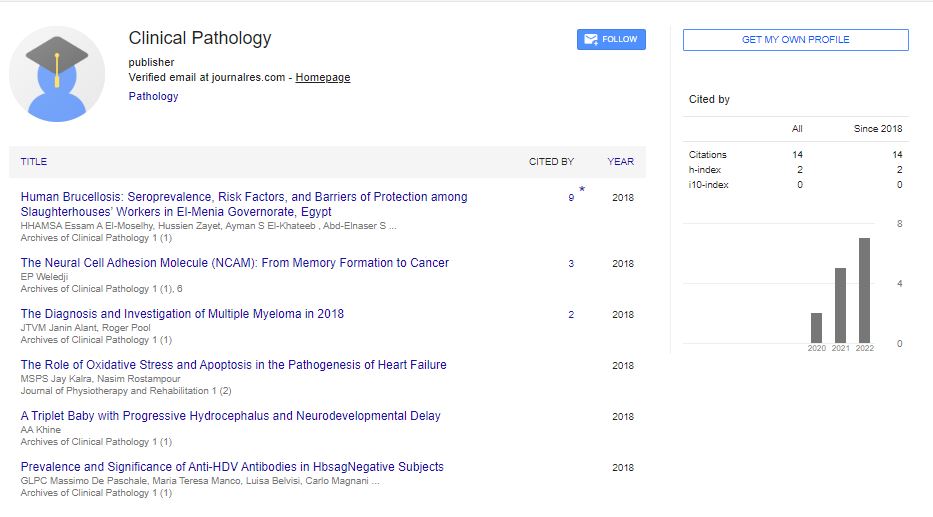Opinion Article, Arch Clin Pathol Vol: 8 Issue: 1
The Function of Molecular Pathology in the Development of Histopathology
David Joseph*
Department of Cellular Pathology, University Hospital of Wales, Cardiff, UK
*Corresponding Author: David Joseph Department of Cellular Pathology, University Hospital of Wales, Cardiff, UK E-mail: joseph.david@uhw.uk
Received date: 28 May, 2023, Manuscript No. ACPY-23-107045
Editor assigned date: 31 May, 2023, Pre QC No. ACPY-23-107045 (PQ);
Reviewed date: 14 June, 2023, QC No. ACPY-23-107045
Revised date: 22 June, 2023, Manuscript No. ACPY-23-107045 (R);
Published date: 28 June, 2023, DOI: 2324-8955/acpy.05.03.100082
Citation: Joseph D (2023) The Function of Molecular Pathology in the Development of Histopathology. Arch Clin Pathol 6:2.
Description
Histopathology plays an essential role in disease diagnosis and management, providing valuable insights into tissue morphology and cellular abnormalities. Traditionally, histopathology relies on the examination of stained tissue sections under a microscope, allowing pathologists to identify structural changes indicative of disease. However, advancements in molecular biology and technology have expanded the scope of histopathology beyond traditional microscopy. Molecular pathology techniques have emerged as powerful tools that enable the analysis of molecular alterations in tissues, providing additional diagnostic, prognostic, and predictive information. This study discuss the application of molecular pathology techniques in histopathology and their impact on disease understanding and patient care.
Molecular pathology encompasses a wide range of techniques that examine genetic, epigenetic, and protein alterations in tissues. These techniques complement traditional histopathology by providing insights into the underlying molecular mechanisms of diseases. Some key molecular pathology techniques used in histopathology include.
Immunohistochemistry (IHC) is a widely used technique that utilizes specific antibodies to detect and visualize target proteins in tissue sections. By staining tissue samples with antibodies against specific proteins, pathologists can determine the presence, localization, and abundance of these proteins in the tissue. IHC is valuable in identifying tumor markers, classifying tumors, and predicting response to targeted therapies.
Fluorescence In Situ Hybridization (FISH) is a technique that allows the visualization of specific DNA sequences or genes within intact cells or tissue sections. By using fluorescently labeled DNA probes that hybridize to complementary target sequences, FISH enables the detection of chromosomal abnormalities, gene amplifications, gene rearrangements, and gene deletions. FISH is particularly useful in diagnosing genetic disorders and identifying specific genetic alterations in cancer.
Polymerase Chain Reaction (PCR) is a technique that amplifies specific DNA sequences, enabling the detection and quantification of target genes or genetic alterations. In histopathology, PCR can be used to detect mutations, gene fusions, viral DNA/RNA, and gene expression levels. Techniques like real-time PCR and reverse transcription PCR (RT-PCR) provide quantitative and sensitive analysis of nucleic acids, aiding in the diagnosis and prognosis of diseases.
Next-Generation Sequencing (NGS) is a high-throughput sequencing technology that enables the analysis of multiple genes or entire genomes in a single experiment. NGS has revolutionized molecular pathology by providing comprehensive genomic information, including mutations, copy number variations, gene expression profiles, and epigenetic modifications. NGS-based panels and whole-exome sequencing have become essential tools for molecular profiling in cancer diagnosis, treatment selection, and monitoring.
The integration of molecular pathology techniques with histopathology has transformed disease diagnosis, prognostication, and therapeutic decision-making. These techniques have numerous applications across different medical specialties:
Molecular pathology techniques provide valuable information for cancer diagnosis, helping to identify specific genetic alterations and molecular markers that aid in tumor classification. For example, IHC can determine hormone receptor status in breast cancer, while FISH can detect HER2 gene amplification in breast and gastric cancers. Molecular profiling with NGS allows comprehensive genomic characterization of tumors, enabling personalized treatment strategies.
Molecular pathology techniques play an essential role in predicting response to therapy and guiding treatment decisions. For instance, in lung cancer, the detection of EGFR mutations by PCR or NGS helps identify patients who are likely to respond to EGFR-targeted therapies. Additionally, IHC can determine the expression of PD-L1, a biomarker for immunotherapy response.
Minimal Residual Disease (MRD) Monitoring Molecular pathology techniques enable the sensitive detection of minimal residual disease, which refers to the presence of a small number of cancer cells remaining after treatment. PCR-based assays targeting specific genetic alterations can detect MRD in various hematological malignancies, allowing early detection of relapse and adjustment of treatment strategies.
Molecular pathology techniques play a vital role in the diagnosis and monitoring of infectious diseases. PCR-based assays can detect the presence of viral, bacterial, or fungal DNA/RNA in tissues, aiding in the identification of pathogens and guiding appropriate treatment.
Molecular pathology techniques are essential in diagnosing and characterizing genetic disorders. FISH can detect chromosomal abnormalities associated with genetic syndromes, while PCR-based assays can identify specific gene mutations or deletions responsible for inherited diseases.
While molecular pathology techniques have significantly advanced disease diagnosis and management, there are challenges that need to be addressed. These challenges include the need for standardized protocols, quality assurance, data analysis, and interpretation, as well as the cost and accessibility of advanced technologies like NGS.
In the future, molecular pathology is expected to continue evolving with advancements in technology and the integration of artificial intelligence and machine learning. This will enable more accurate and rapid analysis of molecular data, improved disease classification, and the discovery of novel biomarkers. Additionally, the integration of molecular pathology techniques with other omics data, such as proteomics and metabolomics, will provide a more comprehensive understanding of diseases and facilitate personalized medicine approaches.
Molecular pathology techniques have revolutionized the field of histopathology, expanding the diagnostic capabilities beyond traditional microscopy. Immunohistochemistry, FISH, PCR, and NGS are among the key techniques used to analyze molecular alterations in tissues, providing additional insights into disease mechanisms, prognosis, and treatment response. The integration of molecular pathology techniques with histopathology has transformed disease diagnosis and personalized medicine, enabling more precise and tailored patient care. With ongoing advancements in technology and research, molecular pathology will continue to play a pivotal role in advancing our understanding of diseases and improving patient outcomes.
 Spanish
Spanish  Chinese
Chinese  Russian
Russian  German
German  French
French  Japanese
Japanese  Portuguese
Portuguese  Hindi
Hindi 